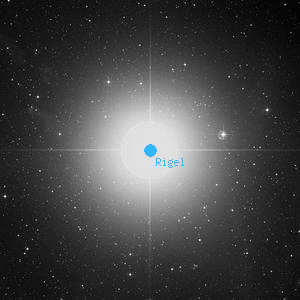Rigel

Overlaid DSS image of Rigel, 60' x 60' with north at top and west to the right
Aladin viewer for the region around Rigel
Algebar, Elgebar, Puanakau, Beta Orionis, β Ori, 19 Ori
BD-08 1063, HD 34085, SAO 131907, GSC 05331-01752, HIP 24436, HR 1713, WDS J05145-0812A
BD-08 1063, HD 34085, SAO 131907, GSC 05331-01752, HIP 24436, HR 1713, WDS J05145-0812A
| Type | Star |
|---|---|
| Magnitude | 0.13 | Right Ascension | 5h 14' 32.3" (2000) |
| Declination | 8° 12' 6" S |
| Constellation | Orion |
| Classification | B8Iae |
Observing Notes
Andrew Cooper
Mar 24, 2020 Waikoloa, HI (map)
20cm f/6 Newtonian, Cave Astrola @ 61x
Seeing: 6 Transparency: 7 Moon: 0%
Brilliant blue-white filling the field with glare, Rigel B is visible just at the edge of the seeing disk in moments of good seeing, faint, no color noted, 6.7 magnitude 9" separation at PA 204°
Andrew Cooper
Apr 17, 2010 Hale Pohaku, HI (map)
46cm f/4.5 Newtonian, Deep Violet @ 175x
Seeing: 7 Transparency: 7 Moon: 14%
Brilliant white primary, magnitude 0.2, a dim companion visible just 9" to the south, magnitude 6.7
Captain William Henry Smyth
Jan 26, 1832 No. 6 The Crescent, Bedford, England (map)
150mm f/17.6 refractor by Tully 1827
A standard Greenwich star, double, in the Hero's right foot, at the commencement of the flexuous Eridanus; it is familiarly termed Rigel, from the Arabic Rijl-al-jauzá, the giant's leg; and Recorde assures us, it was called "Algebar by the Arabitians." A 1, pale yellow; B 9, sapphire blue. This splendid object, which is 33 ♅. II., is somewhat difficult to measure on account of the component's disparity in magnitude, and the brilliance of the large star. Still the results are in gratifying accordance, being:♅. Pos. 201°48' Dist. 6".48 Ep. 1781.76Here ♅.'s positions are from those printed in the Philosophical Transactions for 1785; but H. has made extracts from the original MS. observations, by a mean of which he obtains:
H. and S. 200°41' 8".87 1822.10
D.* 199°48' 9".86 1831.15
Σ. 199°46' 9".14 1831.53
[WDS 202° 9".70 2017 ]Pos. 200°45' Ep. 1791.60 Dist. 9".53 Ep. 1781.81an agreement hardly to be expected under the difficulty of estimating exactly the position of the occult line passing through the centres of two stars so close, and so very unequal. ♅. remarks, "The small star not wanting apparent magnitude, is better seen with my power of 227 than with 460." The proper motion of A has been thus registered:P.... JR -0".05 Dec. -0".02β Orionis has been designated Rá'í al-Jauza in Arabian astrognosy, as shepherd of the Jauza, whose herds, or thirst-allaying camels, are represented by α, γ, δ, and κ. Zahn tells us, in his Oculus Artificialis 1702, that Francis Grindel observed through his telescope, that two stars in the right foot of Orion were surrounded with great splendour, as though emulous of the Sun; and that a phenomenon resembling them in splendour, cannot be found in the whole firmament. Now, as I cannot conceive either λ or τ to have been thus shining in the field with β, I can only impute the remark to a spurious image in a bad instrument, coloured by the same enthusiasm which showed Padre de Rheita the seamless coat of our Lord and a chalice, in this same asterism.
B.... +0".07 -0".01
A.... +0".02 -0".01
[Hipparcos +0".00131 +0".00050]
Independent of the "nautis infestus Orion" character of the constellation, Rigel had one of his own; for it was to the astronomical rising of this "marinus aster" in March, that St. Marinus and St. Aster owe their births in the Romish calendar.
It is easy to find. A line run from the head of Leo through Procyon, arrives at Rigel; as does one from Castor, by Betelgeuze; and the locale of the star is thus expressed:With glittering gems Orion's belt,It will be recollected, that this was one of the stars selected by Count d'Assas de Montardier, a captain in the French navy, for his investigations of parallax; and that he concluded he had detected an amount of from one to two seconds. But as he merely observed its appulse and disappearance behind an iron frame fixed on a mountain at different periods of the year, it would be difficult to prove such a quantity, right or wrong, even if the frame were absolutely immovable during the intervals, and insensible to the variations of temperature.
his sword, his shoulders, blaze;
While radiant Rigel on his foot
pours forth its silver rays.
* The Rev. W. R. Dawes has shown me a diagram which he made of this delicate object, with a two-foot telescope, of l-6/10 inches aperture, made by Dollond, having a pancratic eye-piece charged with a magnifying power of seventy times. This same little instrument showed the companion to Polaris distinctly.― A Cycle of Celestial Objects Vol II, The Bedford Catalogue, William Henry Smyth, 1844
Other Data Sources for Rigel
Nearby objects for Rigel
6 objects found within 120'
| HD 33224 | HD 33432 | Lambda Eridani |
| NGC 1797 | NGC 1799 | Tau Orionis |
Credits...
Drawings, descriptions, and CCD photos are copyright Andrew Cooper unless otherwise noted, no usage without permission.
A complete list of credits and sources can be found on the about page
Rigel